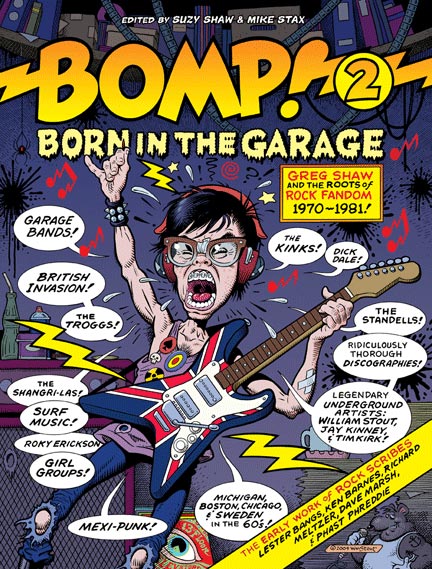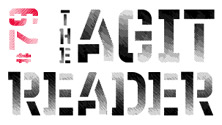
edited by Suzy Shaw and Mike Stax
Bomp!/UT Publishing
To say that without Bomp! what you are reading now wouldn’t exist, is more than likely an understatement. Though this publication has been preceded by the zine explosion of the ’80s and ’90s, the form largely owes its existence to Bomp! and, more specifically, to one man: Greg Shaw. In these days when public expression is just a few clicks to blogger.com away, it’s hard to remember a time when the printed word wasn’t so readily available. (And perhaps even harder to remember when it actually meant something.) When it took some doing to get one’s point of view out there, those who were doing so for little financial reward really had something to say.
Back in the early ’70s, Shaw toiled away in his home in Fairfax, California on a labor of his love of rock & roll. Setting his and a select handful of compatriots’ opinions to type on a typewriter (Google it, kids) and a hand-cranked mimeograph machine (again, Google it), Shaw created what became the prototype for music zines: Who Put the Bomp. (His history with the form actually dates back further, when he created a Tolkien publication, Entmoot, and a sci-fi and music hybrid Mojo Entmooter in the ’60s.) WPTB was to magazines what Nuggets was to records: an indispensable ground zero for what was becoming known as “punk rock.” This was not the spiked and safety-pinned brand of punk to which we’ve all become so familiar, but rather a wide swath of primitive rock made by garage bands across the USA and abroad that were familiar only to a small, but ever growing, tribe of in-the-knows. For Shaw, who used the term in reviewing Nuggets for Rolling Stone in 1973, “punk” was a word used to endearingly describe a certain breed of rock & roll that could be traced throughout the ’50s and ’60s in unchartered surf bands, backwoods axemen, and uncelebrated foot soldiers of the British Invasion. To him, the Shadows of Knight or the Chocolate Watchband were just as punk as the Ramones.
For those attuned to the sounds Shaw and his band of brothers celebrated, WPTB was a wealth of information. Each issue, they delved deeply into their subject matter, whether it be the Kinks, the Standells, or little labels like Autumn Records. They provided extensive discographies and erudite historical information coupled with astute opinions that separated them from mere archivists. And laced within each sentence was a purity of passion that showed that this work stemmed from a gut-level embrace of the subjects at hand, an appreciation that was neither scholarly or geeky, but almost instinctual.
Indeed, Shaw himself was obsessive, but as a listener and disseminator of information, not a collector. (In a humorous anecdote in her introduction, Greg’s ex-wife and business partner Suzy Shaw tells of how his notoriety for the poor condition of his records and the shoddy packaging he used in his mail order business led to record collectors using “Greg Shaw Minus” as the lowest mark for grading a piece of vinyl’s condition.) His guiding hand and voice could be read in every page of Bomp! (to which WPTB had been shortened by 1976) and his other endeavors, most notably the Bomp record label.
A small portion of Shaw’s legacy can be seen in Bomp! 2: Born in the Garage, the second Bomp! book. Assembled is a selection of his work from 1970–1981, including some of his small run, personal zines, Liquid Love and Metanoia. Even amongst this small portion of the issues of Bomp!, the amount of information is vast, so much so that it would take anyone at least several months to digest it all. Just as enjoyable as the reprinted material, though, are the introductions from long-time contributor Ken Barnes, Suzy Shaw, and Jon Savage. It’s an amazing recounting of a period of time perhaps best-suited for Shaw’s endeavor, but that also needed it most. Sadly, Greg Shaw died in 2004, but fortunately he left behind a legacy that speaks for itself, and which can appreciated in all its pre-blog glory here.
Stephen Slaybaugh
The Devil Went Home and Puked: Robert Pollard's Rock Show
Skinny Puppy and Surfer Blood Live Reviews
Light: On the South Side
Eccentric Soul Revue Live Review
The Stooges: The Authorized and Illustrated Story
The Velvet Underground: An Illustrated History of a Walk on the Wild Side
Echo and the Bunnymen and St. Vincent and Andrew Bird Live Reviews
Faust and Os Mutantes Live Reviews
Passion Pit and Austin City Limits Music Festival Live Reviews
Yo La Tengo and Arctic Monkeys Live Reviews
All Tomorrow's Parties: A Fan-Made Concert Film
The Feelies and Arrington de Dionsyso Live Reviews
Our Noise: The Story of Merge Records
Vivian Girls Live Review
